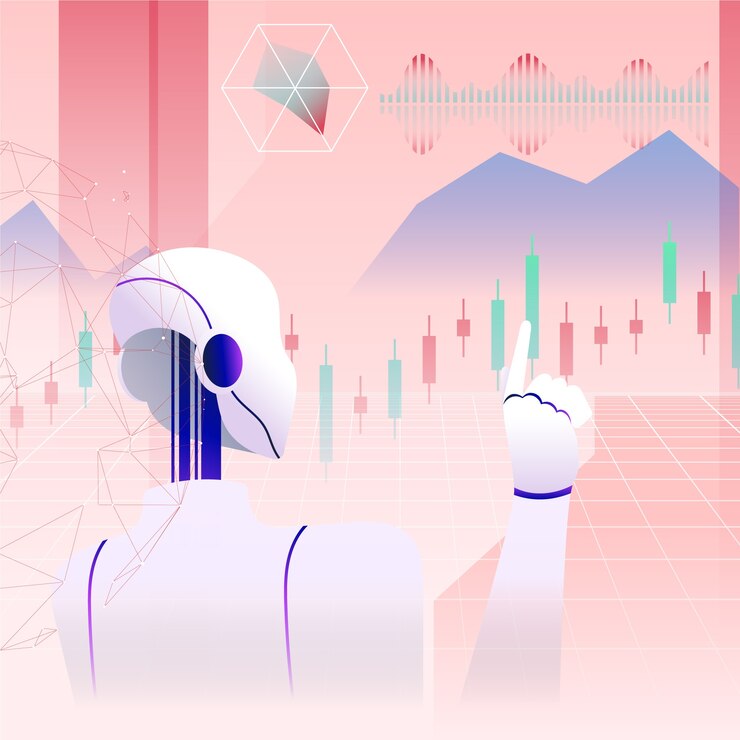The intersection of artificial intelligence and finance has opened up exciting possibilities for automated trading. If you’re intrigued by the potential of AI-powered bots, you might be curious: how do I actually make an AI trading bot? This article provides a starting point, outlining the essential steps involved, from choosing the right AI framework to training your bot on historical data and integrating it with a trading platform. Remember, venturing into AI-powered trading requires a strong foundation in both financial markets and programming concepts.
Understanding AI in Trading
In the realm of trading, Artificial Intelligence (AI) is a game-changer, revolutionizing how financial markets operate. At its core, AI employs machine learning, a subset of its capabilities, to analyze vast datasets. This analysis allows algorithms to discern patterns from historical market data, providing traders with valuable insights into potential future movements.
This predictive prowess is a key aspect of AI in trading. By utilizing advanced algorithms, AI can forecast market trends, identify lucrative opportunities, and even assess potential risks. This predictive analytics capability empowers traders with a strategic advantage, enabling them to make more informed decisions in real-time.
Furthermore, the integration of AI into financial markets goes beyond mere data analysis. AI systems can adapt and evolve based on market dynamics, continuously learning and refining their strategies. This adaptability is particularly crucial in the ever-changing landscape of financial markets, where staying ahead of the curve is synonymous with success.
Benefits of AI Trading Bots
AI Trading Bots, powered by advanced algorithms and machine learning, offer a plethora of benefits that are transforming the landscape of financial trading. Here’s a detailed look at the advantages they bring:
- Improved Decision Making:
- Swift Data Analysis: AI trading bots excel in processing vast amounts of real-time data at unparalleled speeds.
- Pattern Recognition: The bots leverage machine learning to identify intricate patterns and trends, aiding in informed decision-making.
- Reduced Emotional Bias: Unlike human traders, AI bots operate devoid of emotional influences, ensuring rational choices based on data.
- Real-time Data Analysis:
- Market Monitoring: AI bots continuously monitor market conditions, instantly adapting to changes and updating strategies accordingly.
- Quick Response: The ability to analyze data swiftly allows bots to respond to market fluctuations in real-time, optimizing trade execution.
- Risk Management:
- Dynamic Adaptation: AI trading bots dynamically adjust strategies based on risk factors, minimizing potential losses.
- Portfolio Diversification: Bots intelligently diversify portfolios, spreading risk across various assets and optimizing overall performance.
- Automated Stop-loss Mechanisms: AI bots implement automated stop-loss mechanisms, enhancing risk management and protecting investments.
In summary, AI trading bots empower traders by improving decision-making processes, conducting real-time data analysis, and implementing effective risk management strategies. These advantages not only enhance trading efficiency but also contribute to more consistent and profitable outcomes in the dynamic world of financial markets.
Steps to Create an AI Trading Bot
Creating an AI trading bot involves a systematic approach that encompasses various crucial steps. Here’s a detailed breakdown of the process:
- Define Objectives and Strategy:
- Clearly outline the objectives of your AI trading bot, whether it’s focused on high-frequency trading, long-term investments, or specific market sectors.
- Develop a comprehensive trading strategy that aligns with your financial goals, risk tolerance, and market preferences.
- Choose the Right Algorithm:
- Selecting an appropriate algorithm is pivotal. Consider factors like the complexity of the strategy, historical data requirements, and computational efficiency.
- Common algorithms include moving averages, mean-reversion, and machine learning-based models. Choose the one that best suits your trading objectives.
- Data Collection and Preprocessing:
- Gather relevant historical and real-time market data for training and testing your bot. This data can include price movements, trading volumes, and economic indicators.
- Preprocess the data to clean outliers, handle missing values, and ensure consistency, creating a reliable dataset for training your model.
- Model Training:
- Utilize machine learning techniques to train your AI trading bot. This involves feeding it historical data, allowing the algorithm to learn patterns and correlations.
- Fine-tune the model parameters through iterative training to enhance its predictive accuracy and adaptability to changing market conditions.
- Backtesting and Optimization:
- Test the effectiveness of your bot using historical data to simulate real-market conditions. Evaluate its performance against predefined metrics and make necessary adjustments.
- Optimize the bot’s parameters and strategy based on backtesting results, ensuring its robustness and reliability in live trading scenarios.
These steps form a foundational framework for creating an AI trading bot. It’s crucial to approach each phase meticulously, considering the unique characteristics of the financial markets and the specific objectives you aim to achieve. By following these steps diligently, you pave the way for a well-designed and effective AI trading bot that aligns with your trading goals.
Programming Languages and Tools
| Language | Libraries/Frameworks | Data Visualization Tools |
| Python | TensorFlow, PyTorch | Matplotlib, Plotly |
| Java | Deeplearning4j, Apache Flink | Tableau, Power BI |
| R | quantmod, TTR | ggplot2, Shiny |
Choosing the right programming language and tools is crucial in the development of an AI trading bot. Here’s an in-depth exploration of the options available:
- Python for AI in Finance:
- Libraries/Frameworks: Python stands out as a preferred language for AI in finance. TensorFlow and PyTorch are widely used frameworks for developing machine learning models in the financial domain.
- Data Visualization Tools: Matplotlib and Plotly provide robust visualization capabilities, aiding in the interpretation of complex financial data.
- Java:
- Libraries/Frameworks: Java is recognized for its versatility. In the context of AI trading bots, Deeplearning4j and Apache Flink offer powerful tools for implementing machine learning algorithms.
- Data Visualization Tools: Java-based tools might not be as prevalent, but general-purpose tools like Tableau and Power BI can be integrated for visualization.
- R:
- Libraries/Frameworks: R is notable for statistical analysis in finance. Libraries like quantmod and TTR facilitate the implementation of quantitative trading strategies.
- Data Visualization Tools: R boasts ggplot2 and Shiny for creating visually compelling and interactive financial dashboards.
Selecting the right combination of language and tools depends on factors such as your familiarity with the technology, the specific requirements of your trading strategy, and the level of community support available for each option. Whether you opt for the flexibility of Python, the robustness of Java, or the statistical prowess of R, aligning your choices with your bot’s objectives is key to successful implementation.
Challenges in Building AI Trading Bots
Developers often grapple with the challenge of overfitting, where a model performs exceptionally well on training data but struggles to generalize to new, unseen data. Striking the right balance to avoid overfitting while maintaining model accuracy is a delicate task. Additionally, the inherent biases within historical data can pose challenges, potentially leading to skewed predictions and suboptimal decision-making.
Market Volatility
The dynamic and unpredictable nature of financial markets introduces a significant challenge. Sudden market fluctuations can catch AI trading bots off guard, leading to unexpected losses. Adapting algorithms to handle varying degrees of volatility and ensuring the bot can react swiftly to rapid changes in market conditions is a continuous challenge that developers must address.
Navigating these challenges requires a combination of sophisticated algorithmic design, thorough testing, and continuous monitoring to refine and optimize the performance of AI trading bots in the face of real-world complexities.
Future Trends in AI Trading
The future of AI trading holds exciting prospects as technology continues to evolve. One prominent trend is the ongoing evolution of AI algorithms. As computational power and data availability increase, algorithms are becoming more sophisticated, enabling them to discern intricate market patterns and trends with greater precision.
Another noteworthy trend is the integration of AI with blockchain technology. Blockchain’s decentralized and secure nature aligns well with the principles of transparency and trust required in financial transactions. The marriage of AI and blockchain holds the potential to revolutionize the security and efficiency of trading processes.
Looking ahead, AI trading’s impact on traditional trading practices is expected to grow. As machine learning models become more adept at analyzing vast datasets, there’s a likelihood of a gradual shift towards increased reliance on AI-driven decision-making in the financial markets. The future holds promise for a more automated, data-driven, and technologically advanced era in trading.

